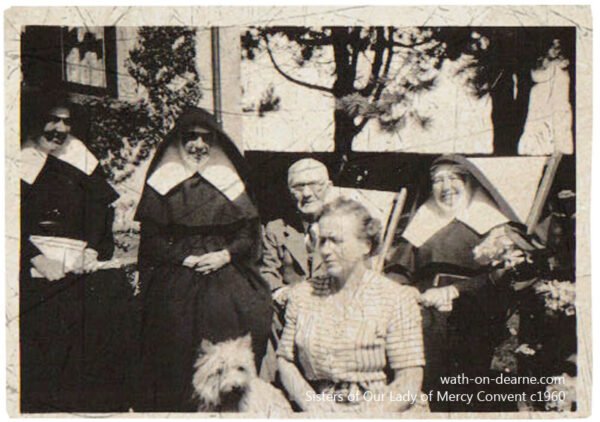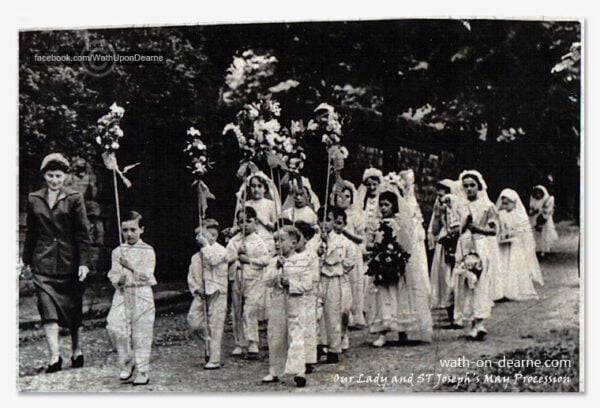 A brief history of St. Joseph’s Roman Catholic Elementary School and its Enduring Impact on Wath-upon-Dearne.
A brief history of St. Joseph’s Roman Catholic Elementary School and its Enduring Impact on Wath-upon-Dearne.
With the misty veil of the past gently lifted, the narrative of a cherished edifice unfolds, a tale steeped in history and education, a tale of St. Joseph’s Roman Catholic Elementary School. This noble establishment graced the leafy lanes of Orchard Place in the quaint locale of West Melton, nestled within Wath-upon-Dearne, a hamlet in the heart of Rotherham, South Yorkshire.
St. Joseph’s, with its stout walls and a roof promising shelter to young minds, commenced its noble journey in the year 1881, enduring until the twilight of 1964. In those many years, it bore witness to the hopes and dreams of countless eager faces and thirsty minds. Its long and illustrious tenure was guided by a distinguished roster of head teachers, each imbuing the school with their distinctive ethos and unique style.
The journey began with the esteemed Miss Elizabeth Moynihan who shaped young minds from the school’s inception until the turn of the century. Subsequently, the reins were handed to Sister Mary Francis Xavier, known in her secular life as Miss B M Doyle, who ably stewarded the school’s course from 1919 until the post-war year of 1949. Then arrived Sister Mary Pius, born as Miss N Smythe, assuming the mantle from 1949 until the dawn of 1963. Finally, it was the turn of Sister Mary Agnes, in the secular world known as Miss B McGrath, who nurtured the school’s final chapter from 1963 until its closure in 1964.
The closing of St. Joseph’s was, however, not the end but rather a transformation. Sister Mary Agnes shepherded its legacy, becoming the headmistress of its successor, Our Lady and St Joseph’s, situated upon Fitzwilliam Street in Wath-upon-Dearne. From the unveiling of this replacement school in 1964 until her retirement in 1989, Sister Mary Agnes guided its evolution with a team of assistant teachers, which included Sister Thomas, Sister Gertrude, Sister Aquinas, Sister Perpetua, Mrs Linda Bayes (née Foye) and Mrs L Sutcliffe. 
When St. Joseph’s first opened its doors, the school had a roll of 175 children, with an average attendance of 130. A veritable hive of young minds, the establishment consisted of four classrooms with senior, junior, and infant cloakrooms at each end of the building, all guarded by a small staffroom. The property also boasted extensive playgrounds for older and younger children alike.
The school became a beacon, drawing eager minds from a wide catchment area, including such locales as Brampton Bierlow, Swinton, Bolton-on-Dearne, Goldthorpe and Thurnscoe. This expansive service continued until the inauguration of Sacred Heart RC Primary School in 1951, when pupils from the Dearne area were transferred.
The school left no stone unturned in its quest for quality education. School meals, an innovation at the time, were introduced in the 1940s. These nourishing repasts were prepared at the Wath Park Road School kitchens and then delivered to St Joseph’s in sturdy metal containers.
Throughout its existence, St. Joseph’s stood as a symbol of inclusivity, welcoming pupils from all denominations. This was exemplified by the attendance record of Ada Ward and her six siblings, regular attendees of West Melton Congregational Chapel, and by Rosemary Cavill Payne, the granddaughter of Sir Richard Payne of the renowned Quaker family of Newhill Hall.
As time danced on, the school continued to evolve. The 1950s brought with it an influx of new pupils, prompting the opening of an additional classroom in the St Joseph’s Parish Empire Hall. Here, Sister Mary Agnes presided over those preparing for their crucial 11 plus examination.
 However, the school was not merely a place of academic study. It was intrinsically tied to the spiritual life of the community, maintaining a close connection with St. Joseph’s R.C. Church. The children were invited to participate in the annual May procession of the Blessed Virgin Mary and the Corpus Christi procession in June.
However, the school was not merely a place of academic study. It was intrinsically tied to the spiritual life of the community, maintaining a close connection with St. Joseph’s R.C. Church. The children were invited to participate in the annual May procession of the Blessed Virgin Mary and the Corpus Christi procession in June.
Finally, in 1964, the ethos of St. Joseph’s was reincarnated in Our Lady and St. Joseph’s R.C. School, a modern, spacious building with five well-equipped classrooms, a large assembly hall/gymnasium, and extensive playing fields. Today, this school continues to honour the tradition of St. Joseph’s, nurturing the minds and hearts of young pupils, instilling in them the moral teachings of the Catholic faith, and encouraging care for each other, the community, and the environment.
Appendix: List of Key Personalities at St. Joseph’s Roman Catholic Elementary School and Community
Headmistresses
- Miss Elizabeth Moynihan (1881 – 1900)
- Sister Mary Francis Xavier (Secular name: Miss B M Doyle, 1919 – 1949)
- Sister Mary Pius (Secular name: Miss N Smythe, 1949 – 1963)
- Sister Mary Agnes (Secular name: Miss B McGrath, 1963 – 1964)
Notable Teachers
- Sister Thomas (Dates not provided)
- Sister Gertrude (Dates not provided)
- Sister Aquinas (Dates not provided)
- Sister Perpetua (Dates not provided)
- Mrs. Linda Bayes (nee Foye, Dates not provided)
- Mrs. L Sutcliffe (Dates not provided)
Class Teachers
- Sister Mercy (Dates not provided)
- Sister Benedict (Dates not provided)
- Sister Berchman (Dates not provided)
- Sister Catherine (Dates not provided)
- Sister Francis (Dates not provided)
- Sister Patricia (Dates not provided)
- Sister Brendan (Dates not provided)
Notable Attendees
- Ada Ward (Date of attendance not provided)
- Rosemary Cavill Payne, the granddaughter of Sir Richard Payne (Attended during the 1940s)
- Helen Curran, the daughter of the Headmaster of Thurnscoe day school (Attended during the 1940s)
Notable Individuals in the Community
- Sir Charles Curran, former Head of BBC Broadcasting (1970s)
- Sir Richard Payne, renowned Quaker family of Newhill Hall (Dates not provided)
Editor’s Comment:
The saga of St. Joseph’s Roman Catholic Elementary School is a testament to the enduring impact of education on a community. Its story speaks to the heart of Wath-upon-Dearne, encapsulating a period of profound societal and educational evolution.
Situated amidst the bucolic setting of South Yorkshire, the school acted as a stalwart beacon of learning and inclusivity. It opened its doors wide to children of varied denominations, cultivating an environment of harmony and understanding. This unyielding commitment to inclusivity played a vital role in fostering a community spirit that transcended religious lines, strengthening the social fabric of Wath-upon-Dearne.
Under the guidance of dedicated educators, St. Joseph’s transformed into more than a mere institution of learning. It became an invaluable nucleus of the community, nurturing young minds, and instilling in them the ethos of mutual respect, kindness, and love for the environment.
Even in its closure, the school left an indelible legacy, one that was carried forward with the establishment of Our Lady and St Joseph’s R.C. School. The continuing commitment to a well-rounded education, grounded in Catholic faith but also emphasizing community and environment, are cherished reflections of St. Joseph’s original mission.
Today, as one strolls down the lanes of Wath-upon-Dearne, one can still feel the subtle echoes of St. Joseph’s Roman Catholic Elementary School. Its tale lives on in the hearts of its former pupils, in the stories passed down through generations, and in the spirit of the community it helped to shape. Its legacy stands as a testament to the transformative power of education and serves as an inspiration for future generations.

Leave a Comment